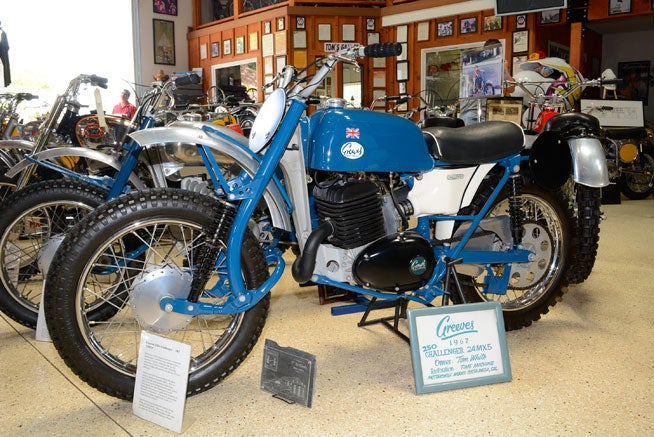
From 1954 to the early 1960s, Bert produced several different models, some trials bikes, some scramblers, even a twin-cylinder roadster, named the “East Coaster.” during these times of unbelievable success, word spread to the United States, and Greeves motorcycles started showing up at motocross events and desert races across the USA. Even in the United States, the big British four-stroke ruled the racetracks and desert races of the time. There were only a few off-brand two-stroke machines in competition, and they usually broke down or underperformed to such a degree that they were labeled as “ring dings,” a disrespectful term based on the noise the engines made, especially before they seized up solid.
But that all changed when Greeves motorcycles started showing up at the start line. Bert Greeves believed that competition improved the breed, and he sought to enter his machines in motocross competition in Europe around 1958. With ace rider Brian Stonebridge (who later perished in a freak car accident), the Greeves banner flew in the newly formed FIM 250cc series of MX races held across Europe. These races were the domain of four-strokes such as the Lito and the Monarch, machines that originated from Swede but incorporated a wide range of English parts such as Norton transmissions, English wheels and hubs and modified BSA forks. They were mated to a long-stroke Albin surplus military generator motor modified by engineering genius Nessie Hedlunds, and they dominated motocross in these early days of competition.
Bert was taken aback, so to speak, when he learned that British riders and motorcycles were considered “second rate” in motocross competition on the continent, and that only redoubled his commitment to produce a truly competitive motocross machine. It paid off, with Stonebridge earning second-place finishes in 2 years of racing in Europe on a machine with a 50cc displacement disadvantage. After Stonebridge was killed in an auto accident, Bert signed a relatively unknown rider by the name of Dave Bickers to the Greeves team. With a new machine punched out to 240cc, Bickers won the 250cc World Championship in 1960 and 1961. The Greeves motorcycle had arrived.
The next “milestone” Greeves motorcycle would be the 1964 MX1 Challenger. To handle the rigors of off-road racing in competition, Bert designed a whole new frame built of stronger tubing, and he modified the leading link forks for greater rigidity and more wheel travel. It not only looked the part of a serious off-road only competition motorcycle, it was a winner.
Gone was the rear swingarm that used an elastomeric band for a spring with rod supported friction dampers, and in its place was a more conventional setup sprung with Girling shock absorbers. The frame still incorporated the alloy “down beam” with two frame members under the engine that connected with the frame where the swingarm pivot rests. The MX! Used fiberglass front and rear fenders, the rear incorporating number plates on each side. Also, the leading link front forks now used a more conventional telescoping sprung fork design that gave another two inches of travel.
The MX1 used a Villiers lower end, but with an in-house Greeves top end. It was not until the MX3 that Greeves used an entirely Greeves-designed and built engine. Legend has it that the top end and piston of the MX1 were cast in the sand floor of the original Greeves workshop where the Invacar was designed and built. The above picture shows a modern Filtron air cleaner setup and not the stock Greeves airbox. Bickers won many races on this machine, as did scrambles and desert riders in the United States. Greeves sold every one he produced. By 1964, Greeves was the bike to be reckoned with in off-road competition on both sides of the pond.
The MX1 gave way to the Greeves Challenger in 1967. Again, the rigors of competition proved that the older design of the original leading-link fork didn’t cut it on the newer style motocross track that incorporated tighter corners. The leading-link suited for long, sweeping corners so common on motocross tracks in Europe, but as the tracks became more technical, Bert found that his bikes didn’t turn all that well.
Perhaps that trait endured itself to desert riders, but MX hands demanded a machine that could carve through a bermed corner, square it off, or ride the berm if the opportunity presented itself. Again, the leading link forks were modified to accept longer travel shock absorbers once found at the rear of most other machines, and it proved once again that Bert was able to change a design quickly to keep on top of the ever-changing world of scrambles and desert racing in the US. By 1967, Greeves was now competing with a new wave of two-stroke motorcycle brands such as Husqvarna, Bultaco, CZ and the one-off specials made by frame manufactures like Hindall and Rickman.
Stay tuned to DirtBikes.com for Part 2 of The Greeves Motorcycle Story.
 Your Privacy Choices
Your Privacy Choices